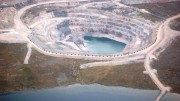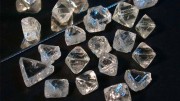Pat Sheahan has always done things her own way.
The diamond researcher and founder of the Sheahan-MDRU literature service — which, in various forms, has been keeping explorers up to date on academic diamond research for decades — simply had to.
One of a handful of women that graduated from the geology program at Carleton University in Ottawa in 1959, Sheahan was the only one in her class to stay in the field, taking a job with Selection Trust (Selco) in Toronto soon after.
Three years into her job as an office geologist doing mostly research (with the odd bit of field work thrown in), she had the first of her two daughters.
“And in those days, you didn’t work,” Sheahan said in an interview in mid-town Toronto, not far from her North York home. “It took me about two months to realize that that wasn’t me.”
Taking her infant daughter with her to the main geology building at the University of Toronto, she started to go through all the journals “just to keep current,” she says.
But she soon realized that the time she was investing combing through geoscientific literature could save others the same effort.
“I began to see different articles that I thought might be of interest to other people and that’s what became the literature service,” she says. “I was doing it for both base metals and gold and for diamonds — but the diamonds became my passion.”
With that, Sheahan neatly carved out a niche for herself, balancing work on a part-time, freelance basis for Selco, monitoring and collecting the latest academic literature with a focus on exploration, and raising a family with her husband Gary. (The two are celebrating their 50th wedding anniversary in December.)
The amount of information available on diamonds was scant in those early days, but that doesn’t mean it was easy to gather.
“The only literature then was from Russia,” she explains.
De Beers, which was active in Canada (as was Selco, in the James Bay lowlands), had no reason to share its proprietary research.
So in order to dive into the only source of information on hand, Sheahan learned Russian, enrolling in a night course at the University of Toronto.
“I learned the alphabet, would be the best way to put it,” she says. But it was enough to identify whether a particular paper dealt with diamond chemistry, geophysics, or was otherwise relevant. The company could then get the article fully translated.
At first, Selco (which later merged with British Petroleum in the 1980s) was Sheahan’s only client. But after it started to turn away from diamond exploration, she opened up the service to other companies, starting her own consulting firm, Konsult International, in the late 1970s.
It was just in time to sate a growing curiosity about diamonds in Canada.
“When the diamond industry took off, in 1987, ’88, ’89, and culminated in Ekati and Diavik, there were a lot of people interested in diamonds, but there wasn’t very much of a flow of information,” Sheahan says.
That was already starting to change as early as the mid-1980s, with fewer restrictions on academics publishing research that was supported by major companies such as De Beers. And that information flow ultimately paved the way for junior companies to enter the industry, Sheahan says.
“That was something that just didn’t happen in the earlier years because they didn’t have the technology, and they couldn’t raise money for it because nobody believed in Canada.”
With the Ekati discovery in the early 1990s, the switch flipped and interest in Canada’s diamond potential ignited. In 1993, Sheahan organized the first-ever short course on diamonds for the Prospectors and Developers Association of Canada (PDAC) convention in Toronto, enlisting 11 of the top experts from around the world to present.
“Normally, the short courses drew anywhere from — if you were really good — fifty to seventy people,” she says. “We had (more than) 400.”
Since then, Sheahan has organized the annual diamond session at the convention.
Sheahan’s also been asked to sit on the boards of several juniors over the years. She’s currently a director of gold explorer Latin American Minerals (LAT-V), which is optioning its Itapoty diamond project in Paraguay to Olivut Resources (OLV-V). And she’s been on the board of uranium and vanadium junior Continental Precious Minerals (CZQ-T) — which started out originally searching for diamonds in Arkansas 23 years ago. (Proud of her many long-running associations, Sheahan is nothing if not loyal.)
And the gleaming 2-carat diamond pendant Pat Sheahan often wears around her neck is an especially treasured symbol of her deep ties in the industry.
That’s because the gem is from the now-defunct Kelsey Lake mine, in Colorado — the only commercial diamond mine that’s ever operated in the United States.

Sheahan was president of the Ontario Club from 1998-99 and 2004-05. Photo Credit: Courtesy of Pat Sheahan.
Sheahan was a director of Redaurum Resources, which operated the small boutique mine from 1996 to 1997, until it ran out of money and had to sell Kelsey Lake, Sheahan says. Before it did, however, the mine spit out some “tremendous” gems, including a 28.3-carat yellow stone that was made into a 5.4-carat cut-and-polished diamond that sold for US$87,500.
She was also a director of Tahera Diamond, which operated the failed Jericho diamond mine in Nunavut.
“The trouble is, you really need a lot of money” for diamond mining, she says. “And things just don’t gel all the time.”
Sheahan is hopeful that Shear Diamonds (SRM-V), which is planning to revive Jericho, will overcome the roadblocks that hindered Tahera.
Because of her visits to diamond mines around the world — from “mom and pop” operations to Brazil to the massive Mir mine in Siberia — and her experience as a director, Sheahan looks at diamond literature with a practical eye. But her expertise isn’t the only reason Sheahan is a central figure in the diamond world. She’s also a proficient networker, which has helped her weather at least four separate downturns in the industry.
“I would sell the literature service, literally, to whomever I was sitting beside on the field trip. I think they probably took it so they didn’t have to listen to me,” she laughs, only half joking.
In preparation for her semi-retirement, Sheahan donated her database of roughly 70,000 article references to the University of British Columbia’s Mineral Deposit Research Unit in 2000 and it was renamed the Sheahan-MDRU Literature Service (formerly known as Scanning Service).
The monthly newsletter lists the latest information published on diamonds — from academic research papers to news and industry articles and conference papers — cross-referenced by source and region. Subscribers can order copies of the individual papers they’re interested in, and can also access a searchable database.
A similar base metals newsletter and database is also available, and MDRU offers research services as well.
The initial trickle of information coming out of Russia all those decades ago has grown to a deluge of information from everywhere. These days, about 3,000 new diamond-related articles a year are added to the database — the most comprehensive publicly available database of diamond literature in the world.
However, since Sheahan handed over the service to MDRU, the number of subscribers has dropped from about 40 — including the big fish like De Beers, Rio Tinto and BHP Billiton, as well as intermediate companies — to about half that.
While the Internet has made searching for and finding information much easier — a function that she has performed for nearly 50 years (“I think I was the Internet before the Internet,” she quips) — Sheahan believes the service is as relevant as ever.
The time subscribers save in searching for information alone is invaluable, and copies of articles are much cheaper from MDRU than ordering directly from the journal.
The unique service has been indispensable to her subscribers over the decades, and serious diamond explorers, like Chris Jennings of Diavik fame, consider the newsletter a “must read” for everyone from academics and government geologists to those in the field, looking to make the next diamond discovery. Jennings, in fact, believes that the more subscribers to the newsletter, the better chance of further advances in the field — and possibly even more discoveries.
“I find this is by far the single most useful source for me in keeping up with what is happening in academic research — which is always the stepping stone to applied advances — and industry,” Jennings wrote in an email.
Brooke Clements, president of Peregrine Diamonds (PGD-T) and another long-time subscriber since the 1980s, says there’s so much information being published these days that it’s difficult to keep up.
“After the Canadian discoveries in the early ‘90s it went from all the papers on diamond exploration probably fitting in one or two notebooks, to — there’s too much now — a deluge.”
And because Sheahan has always collected information on carbonatites (like kimberlites and lamproites, an igneous rock type) she’s hopeful the service will find a new source of subscribers: those looking for information on rare earth deposits, some of which occur in carbonatites.
Now 73, Sheahan is as energetic and plugged in as ever, despite her semi-retired status. In addition to continuing her research for the newsletter on a consulting basis, she still organizes the PDAC’s diamond session each year, and travels the world for site visits and other conferences (the next one is the 10th International Kimberlite Conference in Bangalore in February) on her own dime. She also fits in at least three games of doubles tennis every week — a sport she learned in her 40s, and having never held a tennis racket before.
A big believer in volunteering, she’s edited and/or indexed conference publications, a thesaurus of geological terms published by the American Geosciences Institute, association newsletters and more.
While she has whittled down her professional memberships somewhat — from “all of them” back in the day — she still belongs to the Society of Economic Geologists, Geological Association of Canada (GAC), the PDAC and a few others.
But perhaps Sheahan’s most telling association is with the Ontario Club — an involvement that began back when it was the proverbial old boys’ club, the Engineers Club of Toronto.
A men-only association since its inception in 1895, some members of the Engineers Club were pushing to change that in the early 1980s. It came to a vote on opening up membership to women, and while the motion passed, more than one member resigned over the issue.
Knowing the first female members would have to demonstrate the decision was the right one, engineer David Wahl (now CEO of Ethiopian Potash [FED-V]) invited Sheahan to apply to join as one of the club’s first female members, which she did in 1983.
Sheahan didn’t appreciate at the time what a gutsy move it was, but she was careful not to rock the boat at first.
“I remember going in, they had a lovely dining area and they had a long table for members that came in alone, and people gravitated to the table,” she says, recalling the layout inside the club’s red brick building at the corner of Victoria and Richmond Streets in downtown Toronto.
“After about six months, I went and sat at the table. Dead silence,” she laughs at the memory of the tense moment. “And then they started to chat with me. It had broke the ice, we were fine.”
While another woman who joined at the same time chose not to stay on as a member,
Sheahan rose up through the ranks to become the first female director of the club in the late 1980s. And after the organization merged with the Ontario Club in the early 1990s, she was twice elected president and chairman — “a nice vote of confidence” and another first for a woman. Her initial term in 1998-99 was followed by a second in 2004-05.
A straight shooter with a passion for diamonds that has always won her fans, Sheahan has no regrets about having consistently forged her own path — at the Engineers Club and elsewhere.
“I had to go in the back door,” she says of joining the Engineers Club. “It didn’t bother me — I’ve been going in the back door for a long time.”
To find out more about the Sheahan-MDRU Literature Service, see www.mdru.ubc.ca/home/sheahan-mdru or call 604-822-6088.




Be the first to comment on "Pat Sheahan: A diamond-seeker’s best friend"